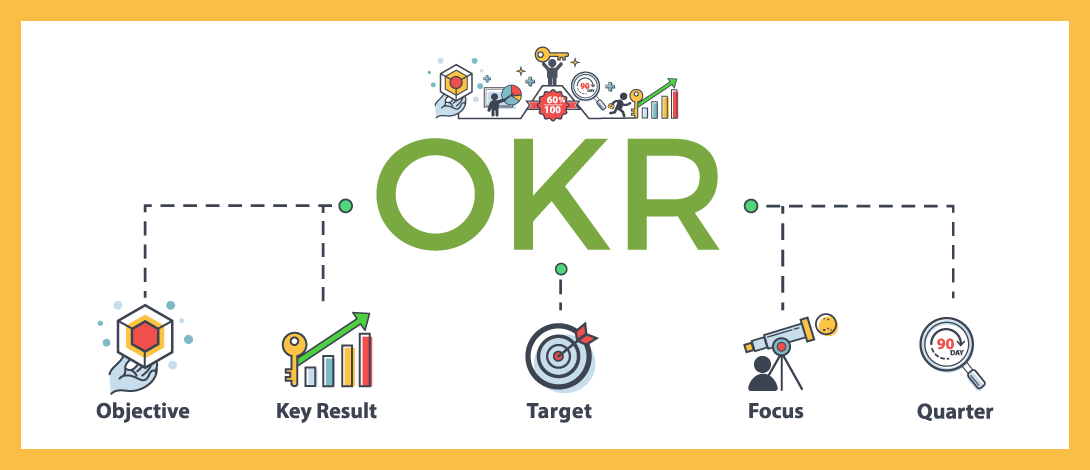
OKRs stand for objectives and key results; they are a strategic form of business optimization and workplace strategy. Used by many famous brands like Google and Spotify, OKRs have become extremely popular for their reputation of guiding companies to achieve their goals quickly. Here we discuss what exactly OKRs accomplish and how your business can use them to achieve results.
OKRs Broken Down
Objectives are qualitative desires that the company plans to achieve. Most of the time, businesses are looking to grow and expand their current position by making the most of different domains. For example, maximizing customer satisfaction is an example of a company-wide objective. The goal is generalized and gives you an idea of the big picture. Although this is indeed a qualitative desire, OKRs follow a similar protocol to SMART goals; therefore, generalized goals cannot be considered objectives until they are specific and measurable.
Let’s say one family-owned restaurant with five full-time employees wants to increase customer growth. To become an OKR objective, this goal would need to include additional specifications. What exactly does “increase” and “customer satisfaction” look like to the company? Increasing customer satisfaction could be measured by factors like compliments on food or service, repeating customers, tips, etc. The business would need to determine which angle best measures increased customer growth before setting out on this goal.
Key results are also measurable outcomes. So, if the objective uses measurements, how do key results use them? You take the objective and go a step further. Suppose the family-owned restaurant decides that they will increase customer growth by tracking the number of customer sales. The key results will specify how this will take place: they define the how-to of the goal. To track customer growth, key results could also look like charting sales each month and averaging the increasing percentage. If the percentage increases every month, let’s say for six months, then the business will know that they have grown in customer growth, achieving their goal. There are tons of other ways to track customer growth, but the main idea is to find a numerical way to track your progress. Without a numerical element, it is difficult to know if a business has met its target.
OKRs and your Business: profit.co
If you’re looking to implement OKRs, remember that OKRs are meant to be versatile enough to fit any business. See where your business falls in terms of applying this strategy and tailor your objectives and key result accordingly. Common goals include increased revenue, customer satisfaction, marketing impact, sales, and employee retention. You can always lean on these essentials if you need a solid place to start. If you need additional assistance, consider experts in OKR establishment and software integrations to ensure that your next company goal is successful. See profit.co for ways to get started.
So, how can your business apply OKRs? Decide on a company-wide goal. Have an open discussion about the company and accumulate ideas from everyone. Remember, a big reason why OKRs work so well is that they equalize the playing field. Giving everyone a chance to speak on behalf of the business should be respected. Once everyone has voiced their opinion, take a vote on the areas to focus on. After the objective has been decided, ensure that it is specific and measurable enough to count as an OKR objective. From there, brainstorm and then solidify key results that will inform you as to whether or not you have achieved your goal. Once the objectives and key results are defined, begin dividing up tasks to workers that collectively provide what is needed to see the key products come to fruition. Stress the importance of individual tasks and encourage employee participation by reiterating that all efforts contribute to the greater goal. You might even consider conducting employee satisfaction surveys throughout the OKR timeframe to see if motivation, work ethic, and a sense of purpose are tied to the OKR integration.
Emphasize Company Participation
Now that we have explained the two components of OKRs let’s discuss how they operate within the company. One of the reasons that OKRs are so successful is because they encourage company participation by everyone. The breakdown of objectives and key results requires that individuals complete independent tasks that contribute to the greater goal. In the end, all of these efforts will have paid off and will have illustrated how parts create the whole. With the idea that there are no small tasks, each player is a crucial figure in the process, and knowing this value helps to facilitate employee satisfaction. With a set agenda in place, the employees know that the work they do will ultimately impact the bigger goal and the efforts of everyone else in the company. Holding this sense of purpose gives a person more pride in their work and conjures up stronger follow-through and motivation. So, what would these pieces-of-the-pie process look like in action?
Referring back to the example of the family-run restaurant, we said that they had five full-time employees and that their goal was to increase customer growth by tracking the average sales each month and comparing these percentages over six months. A close relative to customer growth is customer satisfaction. So how can the employees manifest key results? By offering exceptional service for every customer that walks through the door. How can the business owners do their part? By logging sales each month and coming up with creative ways to gain customer loyalty. Promotions for three-course meals, discount hours, and holiday specials are just some of the ways a small business can bring in more customers. Other ideas include tv advertisements, catering services, and flyers. Taking on these initiatives is just as important as the servers doing their part to put a smile on every customer’s face.
OKRs take time and commitment to execute, but your success is virtually guaranteed once you get the ball rolling. After all, you did the math!
